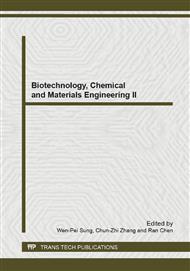[1]
Y. M. Saif, A. M. Fadly, and J. R. Glisson, Diseases of Poultry, twelfth ed., Blackwell Pub., 2008.
Google Scholar
[2]
P. Pathanasophon, T. Sawada, and T. Tanticharoenyos, New serotypes of Riemerella anatipestifer isolated from ducks in Thailand, Avian Pathol, 24 (Mar 1995) 195-199.
DOI: 10.1080/03079459508419059
Google Scholar
[3]
P. Pathanasophon, P. Phuektes, T. Tanticharoenyos, W. Narongsak, and T. Sawada, A potential new serotype of Riemerella anatipestifer isolated from ducks in Thailand, Avian Pathol, 31 (Jun 2002) 267-270.
DOI: 10.1080/03079450220136576
Google Scholar
[4]
C. AnChun, W. MingShu, C. XiaoYue, Z. DeKang, H. Cheng, L. Fei, Z. Yi, G. YuFei, L. ZhaoYu, and F. PengFei, Epidemiology and New Serotypes of Riemerella anatipestifer Isolated from Ducks in China and Studies on Their Pathogenic Characteristics, Chin. J. Vet. Sci., 23 (2003) 320-323.
Google Scholar
[5]
K. Brogden, K. Rhoades, and R. Rimler, Serologic types and physiologic characteristics of 46 avian Pasteurella anatipestifer cultures, Avian Diseases, (1982) 891-896.
DOI: 10.2307/1589877
Google Scholar
[6]
T. Sandhu, M. L. Leister, Serotypes of 'Pasteurella' anatipestifer isolates from poultry in different countries, Avian Pathology, 20 (1991) 233-239.
DOI: 10.1080/03079459108418760
Google Scholar
[7]
M. Ryl, K. Hinz, Exclusion of strain 670/89 as type strain for serovar 20 of Riemerella anatipestifer, Berliner und Münchener tierärztliche Wochenschrift, 113 (2000) 65.
Google Scholar
[8]
W. Xiaojia, Z. DeKang, W. MingShu, C. AnChun, J. RenYong, Z. Yi, C. Zhengli, L. QiHui, L. Fei, W. Yi, and C. XiaoYue, Complete Genome Sequence of Riemerella anatipestifer Reference Strain, Journal of Bacteriology, 194 (2012) 3270-3271.
DOI: 10.1637/9333-917210-digest.1
Google Scholar
[9]
D. H. Haft, J. Selengut, E. F. Mongodin, and K. E. Nelson, A guild of 45 CRISPR-associated (Cas) protein families and multiple CRISPR/Cas subtypes exist in prokaryotic genomes, PLoS computational biology, 1 (2005) 60.
DOI: 10.1371/journal.pcbi.0010060
Google Scholar
[10]
S. J. J. Brouns, M. M. Jore, M. Lundgren, E. R. Westra, R. J. H. Slijkhuis, A. P. L. Snijders, M. J. Dickman, K. S. Makarova, E. V. Koonin, and J. Van der Oost, Small CRISPR RNAs guide antiviral defense in prokaryotes, Science, 321 (2008) 960-964.
DOI: 10.1126/science.1159689
Google Scholar
[11]
K. S. Makarova, L. Aravind, Y. I. Wolf, and E. V. Koonin, Unification of Cas protein families and a simple scenario for the origin and evolution of CRISPR-Cas systems, Biology Direct, 6 (2011)38.
DOI: 10.1186/1745-6150-6-38
Google Scholar
[12]
K. S. Makarova, N. V. Grishin, S. A. Shabalina, Y. I. Wolf, and E. V. Koonin, A putative RNA-interference-based immune system in prokaryotes: computational analysis of the predicted enzymatic machinery, functional analogies with eukaryotic RNAi, and hypothetical mechanisms of action, Biology Direct, 1 (2006) 7.
DOI: 10.1186/1745-6150-1-7
Google Scholar
[13]
H. Deveau, J. E. Garneau, and S. Moineau, CRISPR/Cas system and its role in phage-bacteria interactions, Annual review of microbiology, 64 (2010) 475-493.
DOI: 10.1146/annurev.micro.112408.134123
Google Scholar
[14]
H. Yang, C. Anchun, and W. Mingshu, Analysis of Synonymous Codon Usage in the Cas1 Gene of Riemerella anatipestifer, Accepted for presentation at 5th International Conference on BioMedical Engineering and Informatics (BMEI'12), (2012).
DOI: 10.1109/bmei.2012.6512980
Google Scholar
[15]
R. B. Russell, Genomics, proteomics and bioinformatics: all in the same boat, Genome Biology, 3 (2002) 4034.
Google Scholar
[16]
S. F. Altschul, T. L. Madden, A. A. Schäffer, J. Zhang, Z. Zhang, W. Miller, and D. J. Lipman, Gapped BLAST and PSI-BLAST: a new generation of protein database search programs, Nucleic acids research, 25 (1997) 3389-3402.
DOI: 10.1093/nar/25.17.3389
Google Scholar
[17]
J. D. Thompson, T. J. Gibson, F. Plewniak, F. Jeanmougin, and D. G. Higgins, The CLUSTAL_X windows interface: flexible strategies for multiple sequence alignment aided by quality analysis tools, Nucleic Acids Research, 25 (Dec 15 1997) 4876-4882.
DOI: 10.1093/nar/25.24.4876
Google Scholar
[18]
K. Tamura, J. Dudley, M. Nei, and S. Kumar, MEGA4: molecular evolutionary genetics analysis (MEGA) software version 4.0, Molecular Biology and Evolution, 24 (2007) 1596-1599.
DOI: 10.1093/molbev/msm092
Google Scholar
[19]
P. Schenk, S. Baumann, R. Mattes, and H. H. Steinbiss, Improved high-level expression system for eukaryotic genes in Escherichia coli using T7 RNA polymerase and rare ArgtRNAs, BioTechniques, 19 (1995) 196-200.
Google Scholar
[20]
T. K. Attwood, The role of pattern databases in sequence analysis, Briefings in bioinformatics, 1 (2000) 45-59.
DOI: 10.1093/bib/1.1.45
Google Scholar
[21]
C. P. Carstens, A. Waesche, Codon bias-adjusted BL21 derivatives for protein expression, Strategies Newsletters (Stratagene), 12 (1999) 49-51.
Google Scholar


